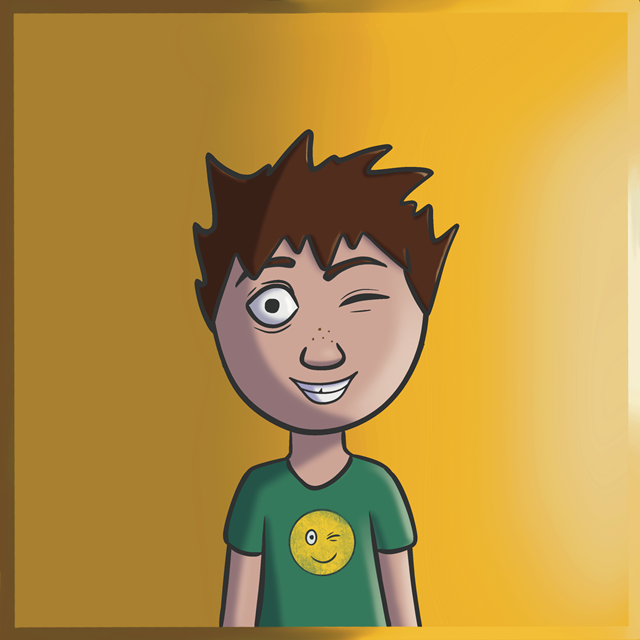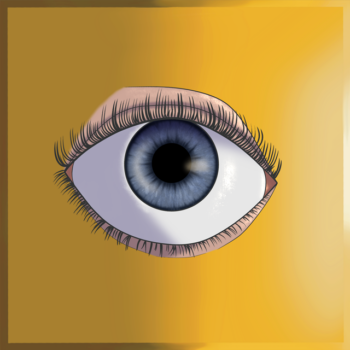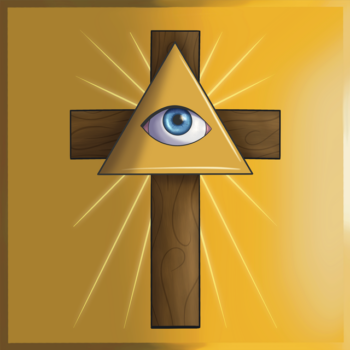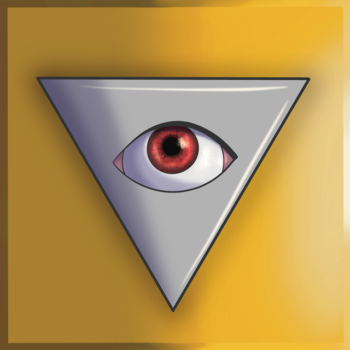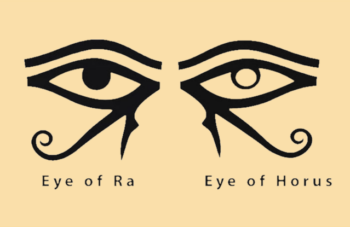Definition:
The “Eye and Smile” is a symbol that consists of a single eye and a smile.
Etymology:
The English word “eye” comes from the Old English “ēage”, which is related to the Proto-Germanic “augō” and the Proto-Indo-European root “okw-“, meaning “to see” or “to look.”
The word “smile” comes from the Middle English “smilen”, which may have Scandinavian origins (such as the Old Norse “smila”) or be influenced by Middle Low German “smilen”, meaning to smile or to laugh silently.
Symbolism:
The Eye and Smile is a symbol representing a prison of fantasy, where illusion, deceit, and emotional manipulation combine to conceal the truth.
This symbol mirrors the Star and Crescent, traditionally associated with Islam. In this comparison, the eye takes the place of the star—representing illusion, fantasy, and deceptive vision—while the smile mirrors the crescent, curving below like a mask that hides true feelings or intentions. Just as the Star and Crescent can be interpreted as a symbol of captivity within an ideological or emotional fantasy, so too does the Eye and Smile portray a reality that appears pleasant and comforting, but is in fact crafted and controlled.
The eye alone symbolizes deception, false enlightenment, or the projection of illusion. The smile adds a layer of emotional disguise—a gesture of friendliness that may be hollow, forced, or weaponized.
Together, they can mean two things:
- The person displaying the Eye and Smile is trapped within fantasy themselves—conforming, performing joy, and unaware of the illusion.
- Or, they are using the Eye and Smile to entrap others—projecting a false world, manipulating perception, and masking control with charm.
A wink is so commonly accompanied by a smile, forming a resemblance to the Islamic symbol of the Star and Crescent, that it’s even included in the wink emoji.

In the opening sequence of the animated children’s show “The Powerpuff Girls,” we see Professor Utonium depicted as a stark black silhouette with his head in profile. Only his right eye is visible—white and crescent-shaped—above a broad, curved mouth, forming the “Eye and Smile” symbol.
This use of stark contrast and partial visibility suggests a duality: light within darkness, or more pointedly, illusion masked as benevolence. The crescent shape of the eye strongly echoes crescent moon symbolism, which in various esoteric and literary traditions can be associated with hidden control, ritual power, and at times, domination masked as beauty or light.
The Professor, having just “created” the girls through an unnatural mixture of sugar, spice, everything nice, and the mysterious “Chemical X,” has committed an impossible act: the spontaneous creation of superpowered children. In symbolic storytelling, impossibilities are rarely literal; instead, they function as metaphors for deeper, more grounded realities.
Here, the impossibility—creating children imbued with fantastical powers—can be interpreted as a metaphor for mental manipulation or ideological indoctrination. Rather than gifting power, the Professor is possibly shaping perception by religious indoctrination. In this reading, the girls are not empowered, but rather made to believe in a fantasy, constructed by an authority figure they trust.
The “Eye and Smile” symbol, then, takes on a darker meaning:
- The eye represents fantasy, control, or deceptive clarity—a gaze that watches and molds.
- The smile suggests false kindness or the mask of joy—a presentation of love and creation that conceals dominance or distortion.
The metaphor reaches further: the manipulation of young minds into believing they are heroic, chosen, or exceptional is a classic allegory for religious indoctrination or ideological grooming. When seen through this lens, the narrative implies a loss of true agency beneath a surface of empowerment.
The sexual abuse symbolism is present here as they are “getting fucked” into believing a scheme.
Additionally, the symbolic crescent has been used in various contexts to imply violation or forced transformation, not necessarily in physical terms, but psychological. The “superpowers” the girls gain could represent the burden of belief, the illusion of autonomy, or the role they’ve been assigned within a structure of control.
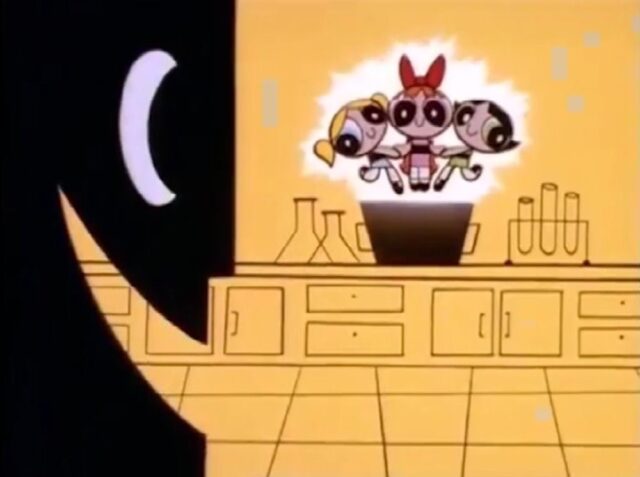
The Eye and Smile is a powerful motif in the animated short film “In-Shadow: A Modern Odyssey” (2017), representing societal pressure to appear happy, while concealing internal suffering, emptiness, or disconnection. The symbol most often takes the form of a smiling mask with exaggerated features, typically shown with only one visible eye — often the right eye — reinforcing themes of distortion, illusion, and identity suppression.
In the first two images, a man stands before a glowing full moon, only his right eye visible. A smiling mask floats in front of him and eventually fuses with his face. The moment it attaches, the mask “comes alive,” its eye lighting up. This transformation symbolizes how individuals are compelled to adopt a false identity in order to be accepted, even if it deadens their true self. The crescent formed by his silhouetted head in front of the moon also enhances the symbolic “eclipse” of authenticity.
We see an image of a group of people partying with alcohol and prescription pills. One woman, dressed provocatively, has beer (visually resembling semen) poured over her masked face, directly covering her right eye. Her fixed smile and hidden eye suggest she’s pretending to enjoy being objectified, highlighting the theme of coerced performance in the pursuit of social validation.
In another image, we see a man and woman lie in bed, hugging, surrounded by alcohol bottles. Both wear the same smiling mask, viewed in profile — once again, only one eye is visible on each. Their interaction suggests a meaningless one-night stand masked as affection, emphasizing the film’s message about the emptiness of connections based on false presentations of happiness.
In one of the images, a showgirl performs provocatively on stage. Her spread legs form an “M”-shape with a blinking arrow pointing at her crotch. Her smiling mask winks as her face aligns with a full moon behind her, forming another crescent symbol. This moment critiques the objectification and commodification of women in entertainment, portraying her as a hollow icon of sexual fantasy.
In one image, a man and a woman sit across from each other, each with their smiling mask, phones placed between them. Social media interfaces surround them. Though they appear to be connecting, the image reveals they’re both filtered by technology and artificial personas, masking their true selves in order to find love or approval.
A similar image of a group of people gather with smiling masks and speech bubbles floating above them. Despite their visible discomfort (cracks and black goo emerging from their bodies), they maintain their smiles. This illustrates how social interactions are often reduced to insincere exchanges, driven by fear of social rejection.
There’s an image where a woman’s mask begins to crack, and through the fracture, her closed right eye is visible — a powerful visual of vulnerability breaking through. Her expression behind the mask reveals the pain and repression she’s been hiding, symbolizing the beginning of her internal collapse under the burden of forced positivity.
In a similar but climactic image, a woman clutches her broken mask with a panicked expression as it splits apart. Her hair flows violently as if caught in a storm. This scene encapsulates the terror of being exposed for who she really is — stripped of the artificial smile, she is overwhelmed by vulnerability.
This use of the Eye and Smile motif throughout the film criticizes a society where people are conditioned to hide behind a mask of exaggerated happiness, even as they suffer in silence. The recurring emphasis on one visible eye, often the right, heightens the symbolism of half-truths and distorted perception — where what is shown is only a fraction of the truth, curated to fit social expectations.
Click to watch the video clips.
In the opening scene of the symbolic short film “I, Pet Goat II” (2012), George W. Bush Jr. is portrayed as a controlled marionette sitting in a classroom with children. This surreal setting parodies the real-life event in which President Bush, after being told that the World Trade Center had been attacked, remained seated and continued listening to children read, rather than reacting immediately. The short film exaggerates this moment by showing Bush as a mindless puppet—his expressions and gestures unnaturally exaggerated—as if performing a freakish, childlike routine without any true awareness or control.
Suddenly, Bush is replaced by another marionette: Barack Hussein Obama. With a charismatic smile and a wink to the children, he begins to laugh—presented as a smoother, more charming character. This transition symbolizes the illusion of political change: a new figure placed on the same stage, not to lead, but to maintain the illusion of progress and comfort the public with theatrics. The film suggests that both are actors in a larger script, not individuals with true autonomy.
This scene vividly encapsulates the prison of fantasy. The eye symbolizes the fantasy itself—the manufactured vision of reality imposed on the masses—while the smile represents our entrapment within that fantasy, sedated by charm, spectacle, and emotional manipulation.
Click to watch the video clip.
In the psychological horror films “Smile” (2022) and “Smile 2” (2024), a chain of suicides unfolds, driven by a sinister curse. The curse passes to anyone who witnesses a person staring at them with a disturbingly unnatural smile before taking their own life. Once cursed, the new victim begins to hallucinate — seeing strangers, loved ones, or even themselves smiling in twisted, unnatural ways, often through reflections or dreams.
Eventually, the curse drives the victim to suicide, but not before they give someone else that same sinister smile — passing the curse on through the trauma of being forced to witness their death.
Those afflicted by the curse live in a constant state of fear and dread. They rarely smile themselves, except in brief moments when the entity — often described as a parasite — temporarily takes control. It’s a relentless battle for sanity. When the entity fully overtakes its host and compels them to end their life, it can be seen as a metaphor for the final imprisonment within a psychopathic fantasy they couldn’t escape.
Both the posters for the first and second Smile films feature one–eye symbolism combined with a sinister smile, visually resembling the Star and Crescent symbol. This imagery symbolizes the characters’ imprisonment within a constructed fantasy — a warped mental state they can’t escape — while also emphasizing the violent symbolism behind the geometric arc shape of the smile itself.
In the Smile films, we see several examples of the sinister smile being shown together with a single eye.
Both the “Smile” (2022) and “Smile 2” (2024) trailers end with nearly identical compositions: the movie title is placed centrally above an upward-curving arc that resembles a smile. Visually, this setup mimics the Star and Crescent symbol. In that symbol, the star sits above or within the crescent shape. Similarly, in these logos, the word “Smile” takes the place of the star, while the arc beneath mimics the crescent.
The movie poster for “The Bad Batch” (2016) features the lower body of a woman wearing bright yellow shorts printed with the classic wink emoji—a smiling face with one eye open and the other closed in a wink. The positioning highlights her buttocks, drawing attention to the smile and one–eye symbolism. She holds a revolver in her hand, blending themes of danger and sexuality. This composition reflects the structure of the Star and Crescent symbol, with the open eye above a curved smile, emphasizing the violent and sexual symbolism often associated with that arrangement.
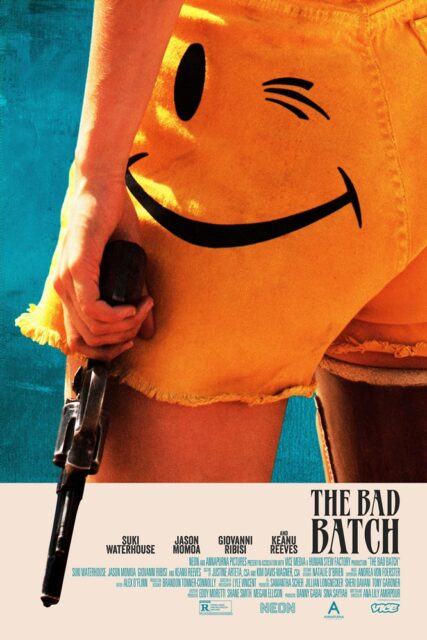
Articles:
Eye
Definition: The “eye” is a complex sensory organ responsible for vision. It detects light and converts it into electrochemical signals, which are then processed by the brain to produce images….
Eye and Archery Bow
Definition: The “Eye and Archery Bow” is a symbol that consists of a single eye and an archery bow. Etymology: “Eye” comes from Old English “ēage,” Proto-Germanic “augon,” Proto-Indo-European “okʷ-”…
Eye of Deception
Definition: The “Eye of Deception” is a symbolic representation that what is being observed or conveyed is false or misleading. It serves as a warning or indication that what is…
Eye of Fantasy
Definition: “Eye of Fantasy” refers to the symbol of a single eye used to represent a situation that is impossible, unrealistic, or inaccurate. It is often used to indicate that…
Eye of Jesus
Definition: The term “Eye of Jesus,” also known as the “Eye on the Cross,” typically refers to a metaphorical or symbolic concept within Christian theology and spirituality. It is not…
Eye of the Devil
Definition: The “Eye of the Devil” typically refers to a malevolent, watchful gaze that symbolizes evil, misfortune, or a sinister presence. It can be interpreted literally, as an actual eye…
Eye of Truth
Definition: The “Eye of Truth” is a symbolic concept carrying dual meanings. The Eye of Truth is used by spiritual people as a metaphor for seeing that which does not…
Eyes of Horus
Definition: The “Eyes of Horus” is an ancient symbol originating from ancient Egyptian mythology where a set of two eyes were referred to as the Eyes of Horus, Udjat, or…
Paragliding
Definition: Paragliding is a recreational and competitive adventure sport where a person flies a lightweight, free-flying, foot-launched glider aircraft with no rigid primary structure. The pilot sits in a harness…
Surfing
Definition: “Surfing” refers to the sport or activity of riding on the forward or deep face of a moving wave, usually on a surfboard. It is often done in the…
